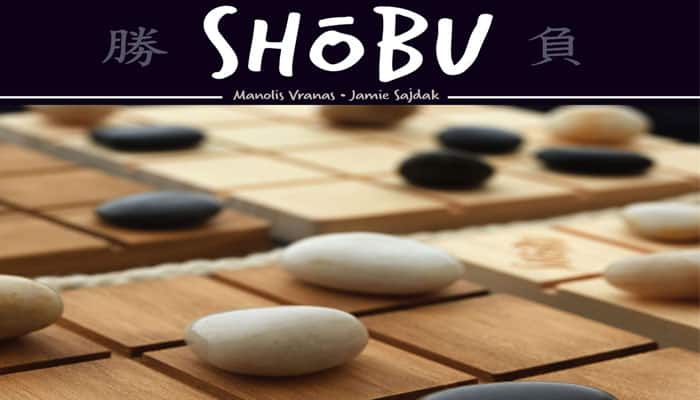

Components
- 4 Wood Boards
- 2 Dark Stones
- 2 Light Stones
- 116 Black River Stones
- 116 White River Stones
- Cotton Dividing Rope
- Instructions
Setup
Arrange the game components as shown, with players sitting opposite one another. In SHOBU, there are four boards of active game play, with four stones of each color per board, arranged as shown.
One player will control ALL the Black stones and the other, White. The two boards closest to each player are called their Homeboards, with the rope marking this division.
One of a player's Homeboards is Dark in color, their other Homeboard is Light.
Object of the Game
Push all your opponent's stones off any ONE of the four gameboards.
Game Play
SHOBU is played in alternating turns, with the Black player taking the first turn.
A turn is comprised of TWO moves: a Passive (or Set Up) move, followed by an Aggressive move.

Passive Move
The Passive (or Set Up) move must be played on one of the player's two Homeboards.
The player chooses one of their color stones and moves it into any unblocked direction, up to two spaces, (no jumping)
Example: Black has chosen to move a stone (fig. a) on their Dark Homeboard. The chosen stone can move as shown; it can move in any direction up to 2 unoccupied spaces. It may not push any other stone.
Aggressive Move
After the Passive move is made, a second matching move is made as the Aggressive move. The Aggressive move must be made in the same direction and number of spaces as the Passive move.
In addition, the Aggressive move must be made on one of the opposite color boards.
Example (continued): Black's Passive move
awas forward 2 spaces on the Dark Homeboard. The Aggressive move must therefore be on either of the two Light boards.An Aggressive move CAN push an opponent's stone across a board
band/or off a board (b2), however pushing a stone is never mandatory. Pushing a stone off a board removes it from the game.
Possible Aggressive moves, fig. b2 removes a stone,
fig. b shoves the white stone two spaces to the edge.
Note: An Aggressive move CANNOT push two stones at once, nor can it push a stone of your own color.
Example: White makes a 2-space diagonal Passive move (fig. a). White's desired Aggressive move (fig. b1) cannot be made, as two stones block the move. Instead, White could choose to move as in (fig. b2) or (fig. b3).
White's turn. Stone b1 cannot push more than one stone.
Important: If an Aggressive move cannot be made, the initial Passive move is also invalid. The player must select a different Passive move.
Players may find it helpful to plan their Aggressive move first and then see if a Passive move is available to support it.
End of the Game
Remove all your opponent's stones from just one board to WIN!
Continue Reading



